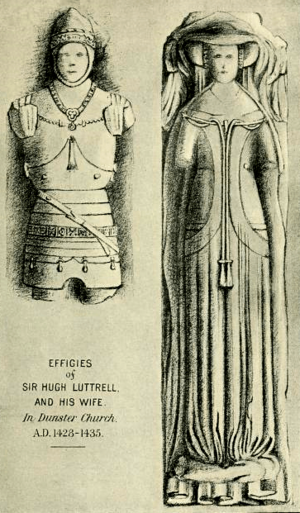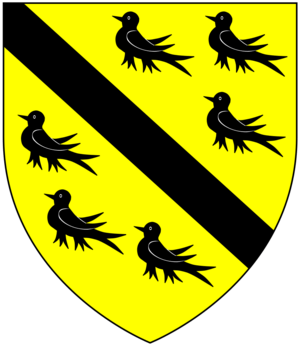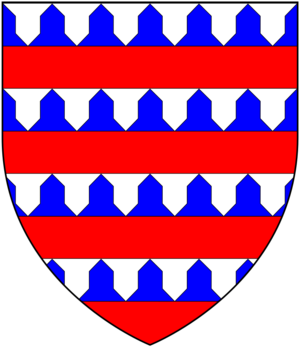Hugh Luttrell (MP, died 1428) facts for kids
Sir Hugh Luttrell (born around 1364 – died 24 March 1428) was an important English nobleman and politician. He lived at Dunster Castle in Somerset. Sir Hugh was a key military leader during the Hundred Years' War. He was also a close friend and advisor to his cousin, King Richard II of England. Later, he became a loyal friend to Queen Anne of Bohemia. He also served John of Gaunt, a powerful duke.
Sir Hugh was elected to the English Parliament several times. He represented the areas of Somerset and Devon.
Contents
Sir Hugh Luttrell's Early Life
Sir Hugh Luttrell was born in Dunster. His mother was Elizabeth Courtenay (died 1395). She was a great-granddaughter of King Edward I of England. His father was Sir Andrew Lutrell. The Luttrell family was an old noble family from Ireland. They were related to the Plantagenet royal family.
Elizabeth Courtenay was very loyal to the royal family. King Richard II of England gave her £200. She used this money to buy a lot of land. This made the family much richer and more important.
Starting His Career
In 1378, Hugh's father passed away. In 1379, Hugh began his own career. When he was about 16, he became an esquire (a knight's attendant) to John of Gaunt. He worked for Gaunt for about 12 years.
After that, he started working for the English Queen, Anne of Bohemia. They became very good friends. Queen Anne gave him many pieces of land. This helped him become even more important among the English nobles. Later, Hugh began working for his cousin, King Richard II. He soon gained many important titles.
Loyalty and New Kings
Sir Hugh was very loyal to King Richard II. He stayed loyal even when the king was put in prison. Hugh was one of the king's closest friends and advisors. When Richard II was killed, Hugh was very sad.
However, Hugh then switched his loyalty to the new king, Henry IV of England. This helped him become even more successful. He did very well during Henry IV's time as king. This was because his family was important and he was very useful to the king.
In 1400, he sailed to Calais in France. He went with his uncle, Sir Peter. His uncle was the commander of the English army there. Hugh worked as the deputy Lieutenant of Calais from 1400 to 1403. In this job, he spent time on political matters. He talked with French officials about peace.
In 1403, he was sent to renew a peace treaty with Flanders. The talks were difficult. The English thought the people of Flanders could not be trusted.
Legal Battles and Parliament
When he returned to England in 1404, he was elected to the English Parliament for the first time. He faced a big problem. A noblewoman named Lady Mohun had died. She had sold land to Hugh's mother. Hugh had inherited these lands.
After Lady Mohun died, her family and Hugh started a legal fight over who owned the lands. Hugh won for a while when he got copies of Lady Mohun's will. The king's court gave him full ownership. The fight calmed down.
But the legal battle had to be settled. In May 1405, Parliament got involved. The fight continued for a year with no clear winner. Then, the House of Commons of England supported Hugh. The debates went on for two more years. In 1408, Hugh finally won. He paid 100 marks to officially take over the lands.
Later Years and Royal Service
Not much is known about Hugh's activities between 1406 and 1414. We know he was at Glastonbury Abbey in 1408. Many other important noblemen were there too. Archbishop Thomas Arundel visited them. They talked about important political and religious issues. In 1410, the Queen of England, Joan of Navarre, made Luttrell her steward. He enjoyed this job.
When Henry V of England became king in 1415, Sir Hugh became even more popular. He went to France with the English army. The goal was to restart the 100 Years' War. He was a brave leader. He was a key commander at the Siege of Harfleur and the Siege of Rouen.
After the siege, he returned to England. In 1417, he began working for King Henry V. He became one of the king's most loyal followers. For the rest of his life, he had a great relationship with the king.
In February 1417, he was made Lieutenant of Harfleur. He went back to France, where the war continued. He had his own group of 20 soldiers and 60 archers. In 1418, he took command of Harfleur. He was ordered to manage the English soldiers there. He was also told to hang any soldiers who ran away.
That same year, Sir Hugh helped arrange the surrender of the French leaders of Montivilliers and Fécamp. In 1419, he also helped get the town of Montreuil and many others to surrender. In July 1419, King Henry V made Luttrell the Royal Seneschal of Normandy. This meant he was the king's main officer in Normandy. He held this important job for two years (1419–1421).
Sir Hugh became the ruler of a very important part of medieval France. He loved governing his new area. He called himself the "great Seneschal of Normandy." Sir Hugh kept Normandy under English control. This helped King Henry V a lot. In 1420, Luttrell wrote to the king many times. He praised Henry's marriage to Catherine of Valois. He wrote that it brought him "the greatest gladness and comfort." He also told the king about the state of the country. He said there were "no evil-doers" but also that the country was poor.
In 1421, he was told to return to England. He was no longer Seneschal of Normandy or Lieutenant of Harfleur. When he arrived in England, Hugh met with many English nobles and royal officials. He also had many royal tasks to do. He continued these tasks until he died.
Sir Hugh Luttrell's Death
On 24 March 1428, Sir Hugh Luttrell became very sick. He died while visiting his daughter, Joan. She was a nun at Shaftesbury. A large funeral procession followed his coffin to Dunster. After he was buried, a monument was built in his memory at the Dunster church. At that moment, one of the most important people in medieval England was laid to rest. He had lived through the reigns of three kings.
Sir Hugh Luttrell's Family
In 1384, Sir Hugh Luttrell married Catherine Beaumont (died 28 August 1435). She was the daughter of Sir John Beaumont. He was an important landowner in Devon.
Sir Hugh and Catherine had six children:
- Sir John Luttrell (born around 1394 – died 1430). He was the oldest son and inherited Dunster. He married Margaret Tuchet around 1422.
- William Luttrell. He was a church leader (rector) in Essex from 1441 to 1443.
- Margaret Luttrell. She married John Cotes.
- Elizabeth Luttrell. She married William Harleston around 1406. Later, after 1423, she married John Stratton.
- Anne Luttrell. She married William Godwyn the younger.
- Joan Luttrell. She became a nun at Shaftesbury.
Famous Descendants of Sir Hugh Luttrell
Sir Hugh Luttrell has many famous descendants, including:
- Robert Carter I: A very rich colonist and slave-owner in Virginia. He was one of the wealthiest men there.
- Benjamin Harrison V: A famous American revolutionary and one of the founding fathers of the United States.
- William Henry Harrison: The 9th President of the United States. He was also an American General during the War of 1812.
- Benjamin Harrison: The 23rd President of the United States.





